Instead, embrace the imperfections and turn it into something delicious, insist chefs
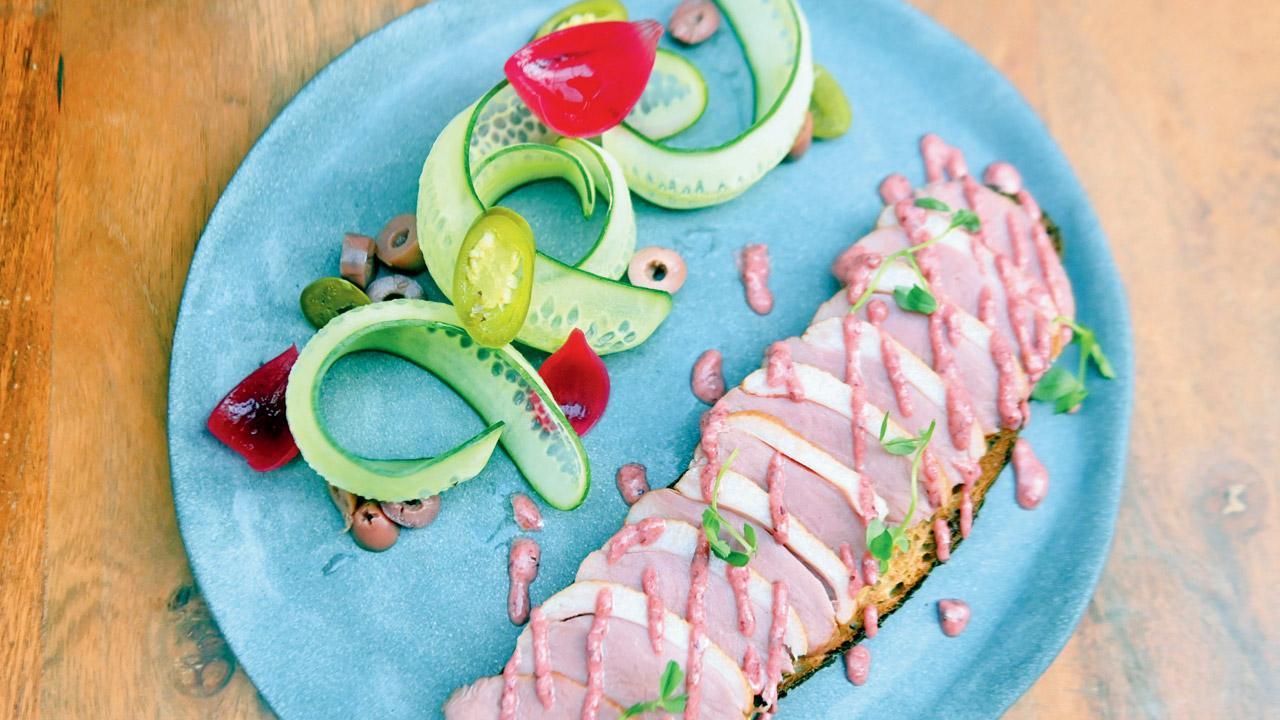
Cherry mustard
We all have that apple sitting in the fridge that’s making us feel guilty for having it past its lifespan. Or, the box of berries that look soft and squishy. The good news is you don’t need to be a master preserver to avoid wasting this bounty. According to a study from the University of Innsbruck in Austria, overripe fruit is packed with healthful compounds like disease-fighting antioxidants called non-fluorescing chlorophyll catabolites. There is a way to make them pretty again as well—cut them into chunks, simmer the roughly chopped fruit into a sauce and blend it into a smoothie. As Hanoze Shroff, executive chef, Saz, Lower Parel, says, “Overripe fruits and berries can be frozen in ziploc bags, and used in smoothies or to make rich sauces and reductions, that can later be added to enhance vinaigrettes or dips. If in doubt whether the fruit is rotten or overripe, it’s best to play safe and send it to the compost pit instead.” But, Chef Arun D’Souza, Perch Wine and Coffee Bar, Bandra, warns against the use of mouldy fruits. As for overripe fruits, he suggests, “Altough past-its-prime produce packs unique nutrients, most would not like the texture of overripe fruit, so mashing and pureeing helps erase the mental block.” Here are a few ways to turn overripe fruits into works of art.
ADVERTISEMENT

Hanoze Shroff, Executive Chef, Saz, pairs overripe cherries with smoked duck breast tartine. Pics/Bipin Kokate
Spread it out
Hanoze Shroff of American brasserie, Saz, uses cherry mustard mayonnaise in his menu. “It’s a fantastic use of cherries as an ingredient because you can taste the sour-sweet depth of the fruit. We pair it with our homemade smoked duck breast tartine, but it goes well with potato chips, as a spread, or even thin it down and use it as a salad dressing.” Since overripe cherries have higher sweetness when paired with mustard and port wine, he says the flavour becomes intense and the vinegar in the recipe balances out the taste.
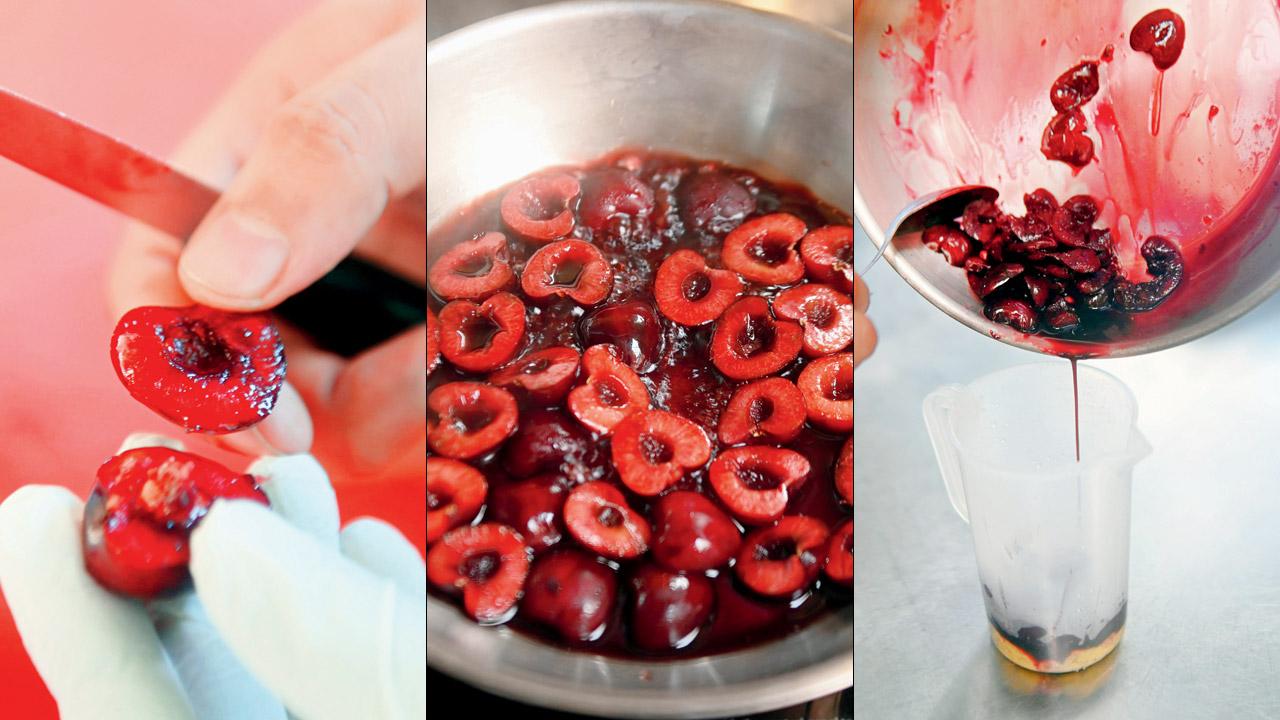
Port wine and Cherry Mustard
Ingredients
400 gm ripe local cherries (hulled)
150 ml Port wine
50 gm black mustard
50 gm yellow mustard
100 ml apple cider vinegar
75 ml water
12 gm salt
30 ml natural honey
15 gm dry mustard powder
1 cup homemade mayonnaise
Method
Simmer the hulled cherries in the port wine for 20 minutes.The cherries should break down and release their juice as well, without letting the pan dry out. Soak both the mustard seeds in the vinegar and water mixture for four hours, blend with honey, salt, mustard powder and the cherry mixture. This should yield a rich red colour. Fold into the homemade mayonnaise for a delicious spread that can be used on toasties, with smoked duck or as a dip with fries.
Jam it in

Shriya Naheta Wadhwa
Zama Organics was founded with a vision to build an ecosystem of sustainable and healthy choices. Their collaborative efforts with farmers go beyond growing organic food and extend to reducing and recycling food waste. “Since organic food comes with a shorter shelf life because of the absence of preservatives, this means that, if not consumed at the right time, they overripen or, worse, get spoiled. To avoid that, we suggest various processes that can be adopted at home to repurpose overripe fruits, from making jams to smoothies and popsicles too,” says founder Shriya Naheta Wadhwa.
Strawberry jam

5 cups overripe organic strawberries
2 cups raw sugar
Method
To begin with, rinse your overripe organic strawberries and pat them dry with a clean kitchen towel. Slice the strawberries, add raw sugar, and leave them in the pan on a low to medium-low heat setting. As the strawberries cook and soften, they will start to release their juices. Continue stirring at intervals until the strawberries have softened. Once the strawberries are soft, decrease the temperature and continue simmering. Stir frequently. You know your jam is ready when the mixture begins to appear translucent and starts to leave the sides of the pan. Relish the strawberry jam on bread, desserts, or even gift a jar full of love to your close ones.
‘Freshness of watermelon and tang of fermentation work well’

Chef Arun D’Souza with the strawberry, watermelon and gin cake. Pic/Atul Kamble
The strawberry, watermelon and gin cake came out as a collaboration between Perch’s bar team and the bakery. Chef Arun D’Souza tells us, “We were looking for ways to use the over-ripened berries which would usually be discarded. This, despite the fact that the flavour [in overripe berries] remained intact. We had a watermelon and gin cake which we were playing around with and the strawberries just added another layer of complexity. After fermenting the strawberries and adding gin, a unique floral flavour emerges. The freshness of the watermelon and the tang of the fermentation work well.”
Strawberry, watermelon and gin cake
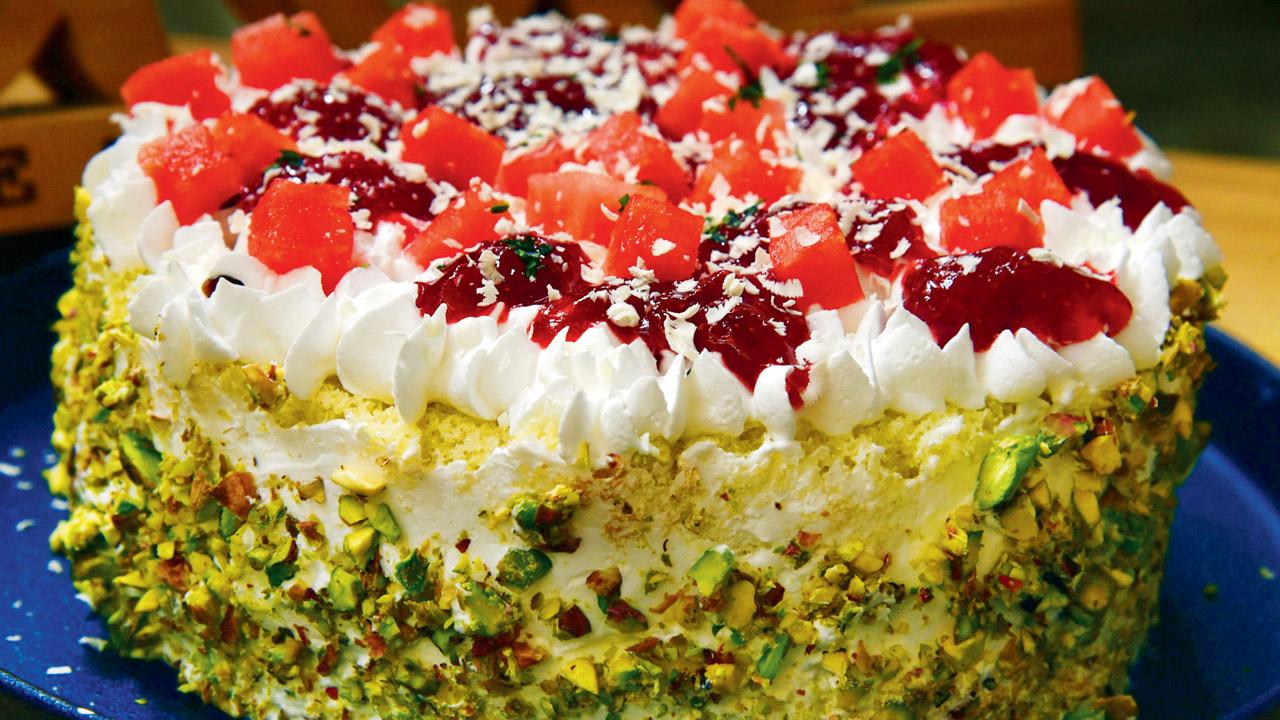
Ingredients
For the fermented strawberries
200 gm overripe strawberries
1 tbsp sugar
2 tbsp whey
90 ml gin
Water as necessary
For the almond sponge
125 gm butter
150 gm caster sugar
3 nos eggs, separated
40 gm flour
75 gm almond flour
For garnishing
1/2 watermelon, thinly sliced, deseeded
500 ml whipping cream
1 tsp rose water
2-3 leaves chopped mint
Method
For the fermented strawberry and gin puree, chop the overripe strawberries and place them in a clean glass jar. Mix in the sugar and cover with water. Add the whey. Cover the top of the jar with a clean cloth and set it aside in a dark area for two to four days. Once fermentation has started, remove the water and set it aside. Flambe the gin and add to the strawberries. Puree and set aside. To make the sponge, preheat an oven to 160 C. Use an electric whip to beat the butter and sugar until light and creamy. Add the egg yolks one at a time until well combined. Add the flour and almond meal and mix well. Beat the egg whites in a separate bowl until stiff and then fold into the mixture. Pour into a greased cake tin and bake for 40-50 minutes, until ready. Remove and let cool. To assemble, cut the cake horizontally into three sections, lightly pour sugar water on each section for additional moisture. On the first layer, add the gin-soaked strawberry puree. With the second, add the watermelon and lightly dust with the chopped mint. Beat whipped cream and add the rosewater. Ice the cake with the whipped cream. Garnish with more strawberry puree, watermelon and chopped roasted almonds.
Drink it up
Roger Gomes, bar head at Ping’s Cafe Orient, Lower Parel, first heard about the pineapple and persimmon tepache in San Francisco—his team included bartenders of Mexican origin who introduced the drink to him. “We first made this [drink] for one of our cocktail trials. The results blew my mind. The best part of making a tepache is that you can control how you want the taste to be. It’s super refreshing and tasty. If you like kombucha, I am quite sure you will enjoy tepache as well,” he adds.
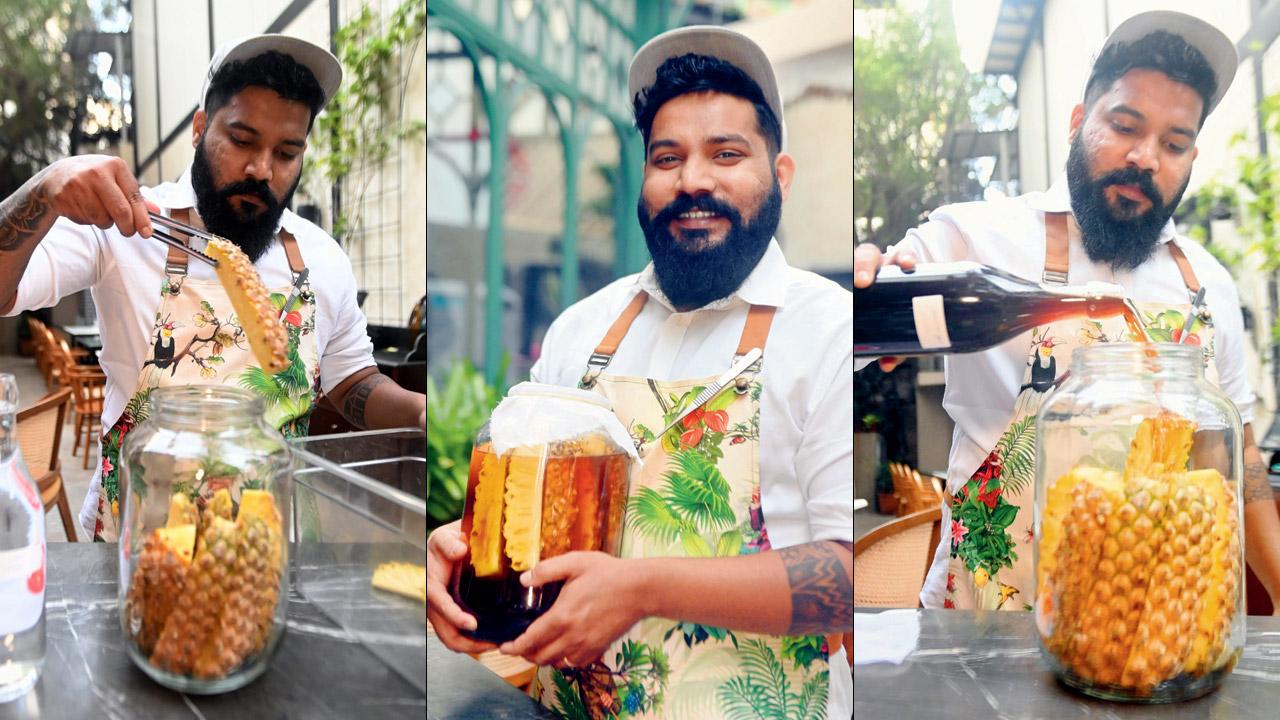
Roger Gomes, bar head at Ping’s Cafe Orient, says the best part of making a tepache is that you can control the taste. Pics/Bipin Kokate
While technically ripe pineapples are used to make tepache, if it’s over-ripened, it expedites the fermentation process. “The best bit about using overripe fruits in cocktails is that they lend more flavour than fresh ones. However, they can’t be stored for too long. They also attract a lot of fruit flies, which are tough to get rid of. I recommend recycling the unused overripe fruit in compost,” says Gomes.
Pineapple and persimmon tepache
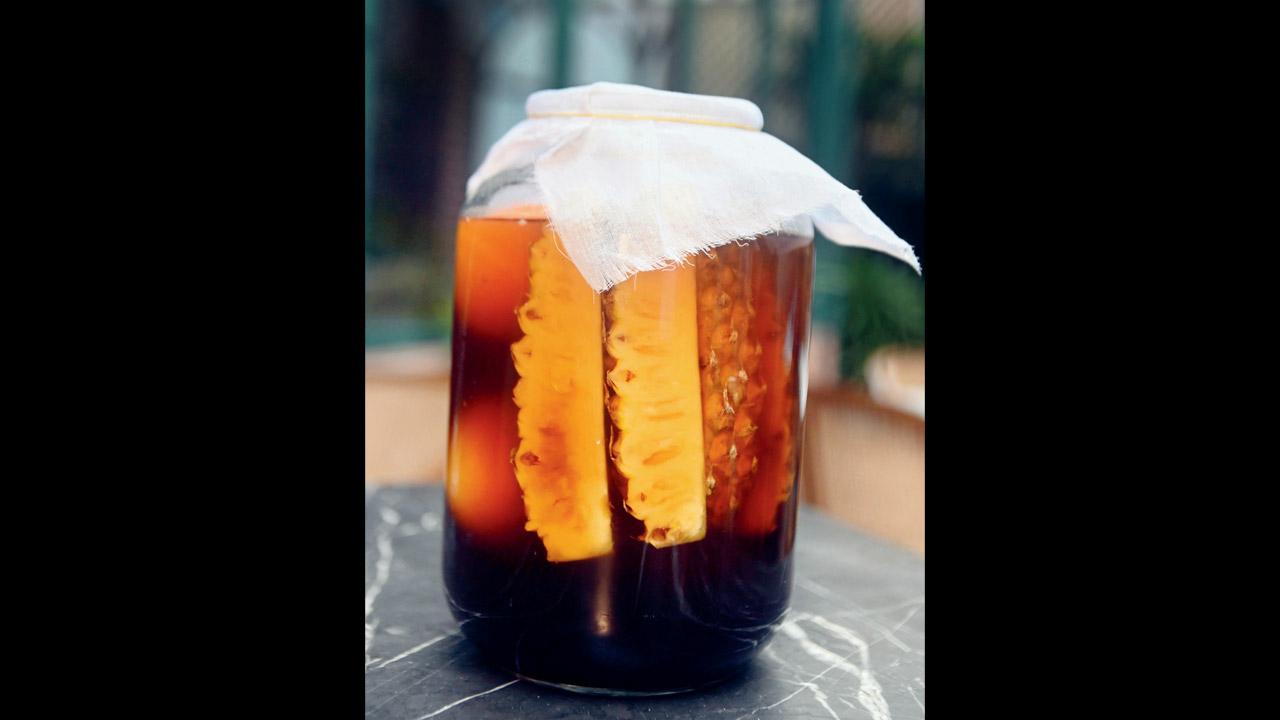
1 overripe pineapple
3-4 persimmon
500 gm brown sugar
1 litre water
2-3 cinnamon sticks
5-6 cloves
Method
Combine water, brown sugar and spices in a pot. Heat the pot on low flame. Stir continuously till all the sugar dissolves. Simmer for about five minutes and take off the heat and let cool. Cut the pineapple in long strips (skin on) and place it in a mason jar. Dice the persimmons and add to the jar. Add the concoction over the cut fruits and stir gently.
Make sure that all of the fruits are submerged in the liquid. The enzymes on the skin of the pineapple will start to work their magic in a couple of days. The fermentation process usually takes about 4 to 5 days. You can ferment as per your taste; keep checking. Once satisfied, store in a clip-top bottle and burp the bottle every day or you can add some alcohol to stop the fermentation process.
 Subscribe today by clicking the link and stay updated with the latest news!" Click here!
Subscribe today by clicking the link and stay updated with the latest news!" Click here!







